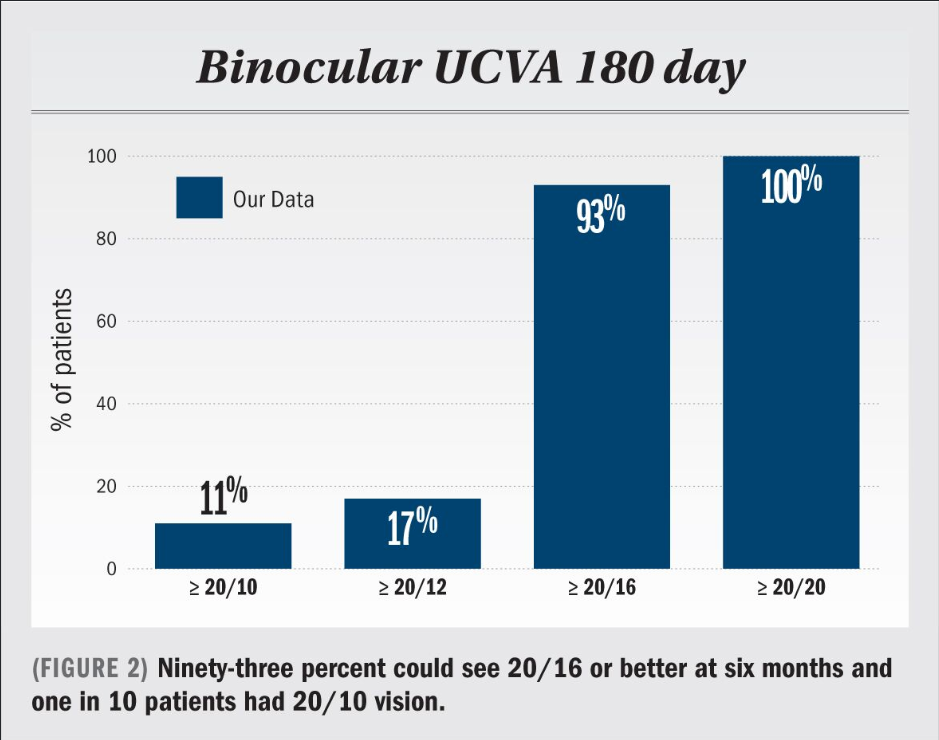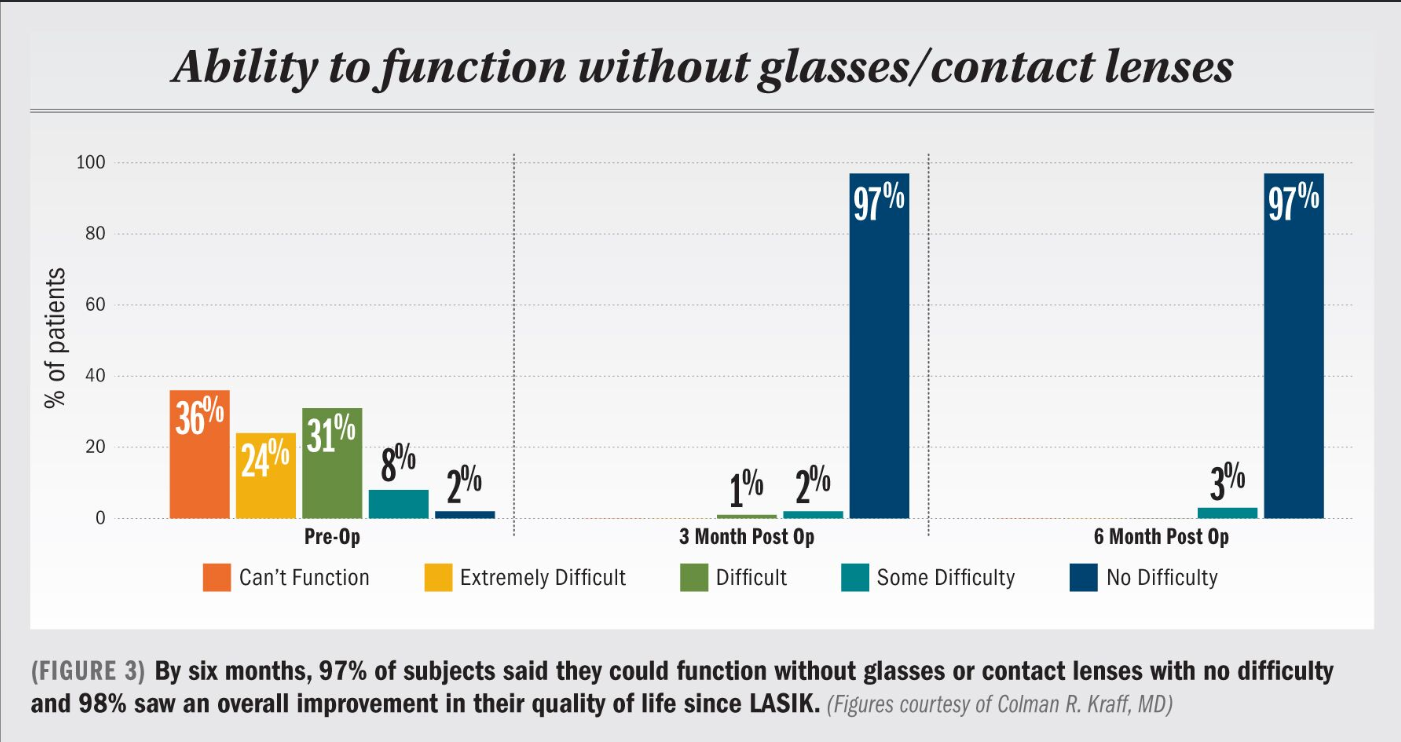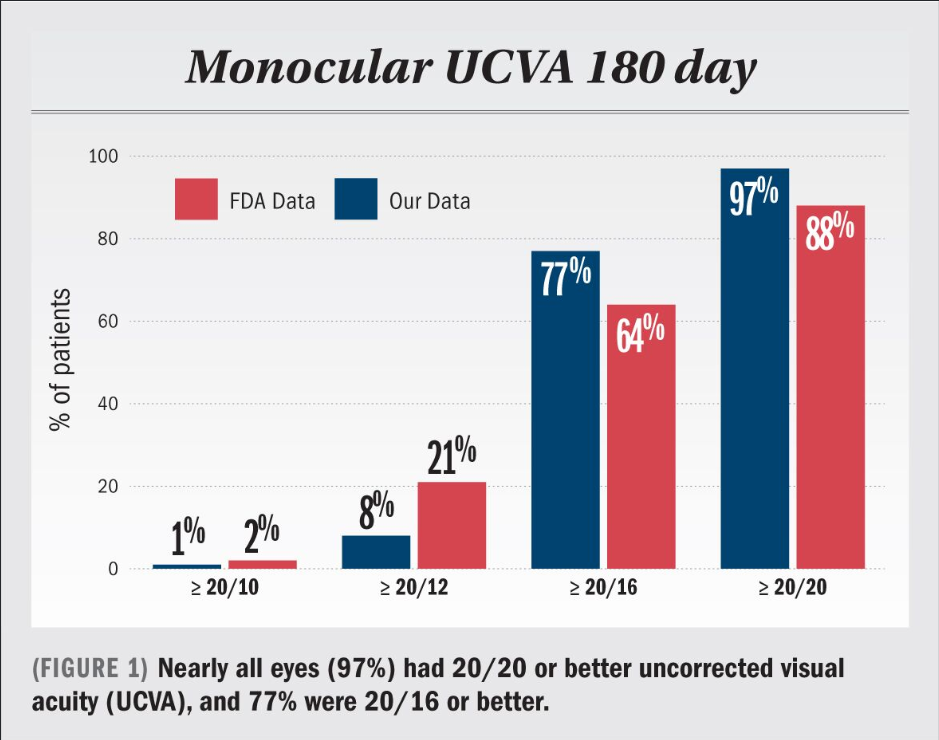Article
Finding value in real-world aberrometry outcomes
Author(s):
Researchers explore clinical and patient-reported outcomes after WFG LASIK for myopia



Use of high-definition wavefront aberrometry may improve the chance of better-than-20/20 results and high patient satisfaction, according to Colman R. Kraff, MD.
Since the FDA approval of a high-definition wavefront aberrometer (iDesign Advanced Wave Scan, Johnson & Johnson Vision) in 2015, this technology affords a broader range of patients-including those with higher astigmatism-to be treated with custom, wavefront-guided ablations. In the FDA clinical trial, 64% of 344 eyes had monocular uncorrected visual acuity (UCVA) of 20/16 or better at six months.
Robert Maloney, MD, Stephen Coleman, MD, and I wanted to evaluate whether we could reproduce the FDA clinical trial results in a real-world clinical practice setting and determine the impact on patient satisfaction.
We conducted a multicenter, open-label study with a target enrollment of 100 patients, who were to be examined at baseline, 1 day, and at 30, 60, 90, and 180 days postoperatively.1 The study was open to patients with a wide range of myopic refractive error, from –0.25 D to –11.00 D, with or without astigmatism of up to 5.00 D. All subjects had to have best-corrected visual acuity (BCVA) of 20/20 or better preoperatively, no uncontrolled ophthalmic disease (including severe dry eye), and no prior corneal surgery.
All were slated for plano corrections (no monovision). All patients were treated with iDesign-guided LASIK treatments using the VISX Star S4 IR laser and the iFS femtosecond laser for flap creation (Johnson & Johnson Vision). Flap thickness and architecture were at the surgeon’s discretion.
Study results
The mean age of patients enrolled was 30 (range: 18 to 47). Sixty subjects were male and 35 female. Preoperative manifest refraction sphere ranged from –0.25 to –7.75 D (mean: –3.40 D). At six months the mean sphere had been reduced to 0.11 ±0.263 D. Preoperative manifest refraction cylinder ranged from 0 to –5.00 D at baseline (mean: –0.87 D) and was reduced to –0.22 ±0.263 D.
The mean spherical equivalent was reduced from –3.83 ±1.92 D to plano (0.00 ± 0.242 D). At six months, our visual acuity results were even better than those reported in the FDA clinical trial for iDesign. Nearly all eyes (97%) had 20/20 or better UCVA, and 77% were 20/16 or better (Figure 1). When we looked at binocular vision, 93% could see 20/16 or better at six months and one in 10 patients had 20/10 vision (Figure 2).
These are some of the best visual acuity results we’ve seen in any multicenter clinical trial. At six months, patients were asked how often their eyes felt dry or gritty; 99% said “none of the time” or only “sometimes,” an improvement over the percentage that answered this way preoperatively.
The proportion of people saying they were bothered by starbursts, halo, glare, or double vision more than “none of the time” or “sometimes” was very low but also decreased from preoperative to six months postoperative.
By six months, 97% of subjects said they could function without glasses or contact lenses with no difficulty (Figure 3) and 98% saw an overall improvement in their quality of life since LASIK surgery. (No one said their quality of life was worse.) Not surprisingly, 99% said they would recommend the procedure for friends or family.
Lessons learned
Even as technology has steadily improved, the lessons of the past 20 years of refractive surgery still hold true. We must choose good candidates with healthy eyes, and be sure to treat pre-existing conditions such as dry eye and meibomian gland dysfunction (MGD) before refractive surgery.
Dry eye and MGD are extremely common in patients presenting for LASIK, given that contact lens intolerance due to MGD and evaporative dry eye was often the catalyst driving them to seek refractive surgery in the first place.
The ability of new aberrometry devices to image and capture more aberrated eyes does not mean every eye that can be captured should be treated. Surgeons have to be rigorous in evaluating more aberrated eyes and those requiring large corrections and be mindful of tissue consumption in treatment planning.
Patients with high astigmatism can now be treated with very good clinical outcomes. However, extremely high astigmatism is uncommon and does require careful assessment of refractive stability and of corneal cylinder. I want to see inter- and intraocular topographic symmetry on Placido disc analysis as well as normal indices on Pentacam (Oculus), including symmetrical anterior and posterior elevations and a normal Belin Ambrosio analysis.
It is also important to consider any family history of ectatic disease and discuss the potential for night-vision issues with patients with these unusual corrections. The average age of patients in the study discussed here (30) reflects the reality that today’s laser vision correction patients are generally younger than the average patient a decade or more ago. The millennial generation represents a great opportunity for refractive surgery centers, simply because it is so large.
These patients can be challenging to reach through traditional advertising so practices must delve more into social media outreach. This generation also has the advantage of having seen older friends and family reap the rewards of successful LASIK. In my experience, they are more confident in the procedure and less fearful of complications than earlier generations.
Conclusion
A new version of the iDesign aberrometer was just approved and will be commercially available soon. It provides surgeons with additional maps and analyses and is likely to further incorporate topographical and keratometric data into the treatment planning.
Additionally, it increases the range of hyperopic astigmatism that can be treated. We are fortunate that our refractive surgery technology continues to improve and to provide even better outcomes for our patients.
Disclosures:
Colman R. Kraff, MD
E: ckraff@kraffeye.com
Dr. Kraff is in private practice at Kraff Eye Institute in Chicago and serves as a clinical instructor at Northwestern University Medical School. He is a consultant to Johnson & Johnson Vision and serves on the International Advisory Board for Optical Express.
References:
1. Kraff CR, Maloney RK, Coleman SC. Clinical and patient reported outcomes after wavefrontguided LASIK for myopia using a high-definition Hartmann Shack aberrometer. ASCRS 2018.





